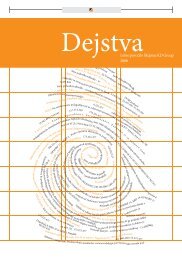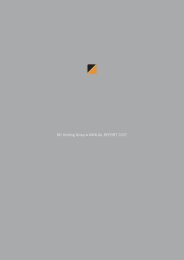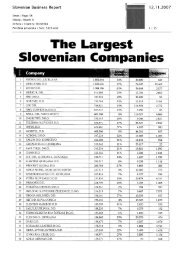The Group KD Group and KD Group dd
The Group KD Group and KD Group dd
The Group KD Group and KD Group dd
Create successful ePaper yourself
Turn your PDF publications into a flip-book with our unique Google optimized e-Paper software.
<strong>The</strong> <strong>Group</strong> <strong>KD</strong> <strong>Group</strong> Annual Report 2009<br />
Notes to Consolidated Financial Statements as at <strong>and</strong> for the year ended 31 December 2009<br />
<strong>Group</strong> companies<br />
<strong>The</strong> financial statements of all <strong>Group</strong> entities (none of which has the currency of a hyperinflationary economy) that have a<br />
functional currency different from the presentation currency of the <strong>Group</strong> are translated into the presentation currency as<br />
follows:<br />
- assets <strong>and</strong> liabilities for each balance sheet presented are translated at the reference rate of ECB or Bank of<br />
Slovenia exchange rates on the date of the balance sheet;<br />
- income <strong>and</strong> expenses for each income statement are translated at the average annual reference rate of ECB or<br />
Bank of Slovenia exchange rates;<br />
- all resulting exchange differences are recognised as a separate component of equity (reserves).<br />
Upon consolidation, exchange differences arising from the translation of the net investment in foreign entities are transferred<br />
to other comprehensive income. When a foreign operation is sold, such exchange differences are recognised in the income<br />
statement as part of the gain or loss on sale.<br />
2.5 Property, plant <strong>and</strong> equipment<br />
Property, plant <strong>and</strong> equipment are l<strong>and</strong>, buildings <strong>and</strong> equipment used by the <strong>Group</strong> for the performance of its activities.<br />
After initial recognition, property <strong>and</strong> equipment are carried at historical cost less accumulated depreciation <strong>and</strong> accumulated<br />
impairment losses, if any (cost model). Historical cost includes expenditure that is directly attributable to the acquisition of the<br />
items. Subsequent costs are included in the asset’s carrying amount or recognised as a separate asset, as appropriate, only<br />
when it is probable that future economic benefits associated with the item will flow to the <strong>Group</strong> <strong>and</strong> the cost of the item can<br />
be measured reliably. All other repairs <strong>and</strong> maintenance are charged to the income statement during the financial period in<br />
which they are incurred. If the cost of an item of property, plant <strong>and</strong> equipment is significant, it is allocated to its individual<br />
parts. If the parts are significant in relation to the total cost, <strong>and</strong> have different useful lives, each individual part of the asset is<br />
accounted for separately.<br />
An item of property <strong>and</strong> equipment is derecognised upon disposal or when no further economic benefits are expected from<br />
the asset. <strong>The</strong> gain or loss arising from derecognition of an item of property or equipment is determined as the difference<br />
between the disposal proceeds <strong>and</strong> the carrying amount of the item, <strong>and</strong> is recognised in other operating income or<br />
expenses.<br />
Depreciation<br />
<strong>The</strong> <strong>Group</strong> systematically allocates to profit or loss the cost less residual value (depreciable amount) over the useful life of<br />
each individual item of property, plant <strong>and</strong> equipment. <strong>The</strong> <strong>Group</strong> uses the straight-line depreciation method. L<strong>and</strong> is not<br />
depreciated.<br />
Depreciation is calculated individually.<br />
<strong>The</strong> useful lives are as follows:<br />
Property, plant <strong>and</strong> equipment<br />
Buildings<br />
Vehicles <strong>and</strong> machinery<br />
Furniture, fittings <strong>and</strong> equipment<br />
20 to 59 years<br />
3 to 10 years<br />
2 to 7 years<br />
<strong>The</strong> assets’ residual values <strong>and</strong> useful lives are reviewed at least once a year on the balance sheet date <strong>and</strong> restated if<br />
appropriate. If the asset’s recoverable amount is lower than its book value the asset is written down immediately to its<br />
recoverable amount <strong>and</strong> the impairment loss is recognised in the income statement. <strong>The</strong> recoverable amount is the higher of<br />
an asset's value in use <strong>and</strong> fair value less costs to sell (see Note 2.1.10).<br />
91







